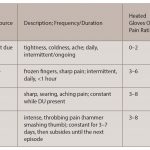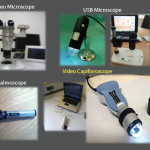Sensation: The West Enhanced Sensory Test (WEST, Danbury, Conn.) was used to assess sensation. The tips of different diameter monofilaments were pressed onto Barb’s finger to determine the smallest amount of bending force she could detect. The monofilaments were scored in terms of grams (g): 0.07 g within normal range, 0.2 g reduced tactile, 2.0 g reduced protective, 4.0 g loss of protective and 200 g residual sensation. Uddin et al used weighted kappa and percent agreement to indicate test–retest reliability of the WEST and used the percentage of normal controls that achieved a normal score to determine validity.38 Test-retest reliability was excellent (k = 1). Average percentages of normal detection on one test–retest (detection level = 4/5) was 93% and 97%; another (detection level = 5/5) was 82% and 85%.
Dexterity: Dexterity was assessed with a nine-hole peg test. The object was to insert nine pegs into holes and remove them as fast as possible with one hand. This was conducted with right and left hands as recommended by Mathiowetz et al.39 In healthy adults, test–retest reliability coefficients were 0.95 right hand and 0.92 left hand.39 This test showed good criterion validity with adequate correlation (P = -0.74 to -0.75) with the Purdue pegboard and excellent correlation with the Bruininks-Oseretsky Test of Motor Proficiency (P = -0.87 to -0.89).40
Hand Function & Joint Mobility: Functional mobility was assessed using the Hand Mobility in Scleroderma (HAMIS) test. The test consists of nine items that assess finger flexion and extension, finger and thumb abduction, pincer grip, wrist flexion and extension, pronation and supination. Both hands are assessed and graded separately. Each item is graded 0–3, with 0 indicating the subject can perform the action and 3 denoting the subject cannot perform the action. A maximum score of 27, for each hand, indicates a high degree of hand dysfunction.41 The HAMIS has an excellent test–retest reliability (ICC = 0.99).42
The Modified Kapanji Index (MKI) was used to assess joint mobility.43 The MKI scores thumb opposition and long finger flexion and extension using numbered anatomical landmarks on the hand, such as the tip of the 5th digit and the flexion creases on interphalangeal joints. Each landmark is numbered in order, starting with 1. The higher numbers require greater ROM. The highest number the thumb or finger can reach on its respective hand is the score for that finger. The sum of scores for finger ROM and thumb opposition for right and left hands are combined. A maximum score of 100 indicates normal mobility. MKI has good interobserver reliability (ICC 0.9, 95% CI range from 0.821–0.944) and correlates well with the goniometer.43
Pre-Intervention Measures
On Sept. 26, 2016, an occupational therapist collected Barb’s baseline data, including pain, DU, hand strength, AROM of bilateral wrists and 2nd and 5th digits, sensation, dexterity, HAMIS and MKI. Initial patient measures are summarized in Tables 1–3.
Primary Measures
Pain: Baseline average pain with and without heated gloves was calculated using fall and winter 2015–2016 data. At that time, Barb wore the heated gloves intermittently for Raynaud’s pain management, then more frequently and for longer durations when the DU on her left second digit returned in November. NRS ratings with and without gloves captured pain from Raynaud’s, DUs and acro-osteolysis. Pain was assessed daily, three to four times per day between Dec. 6, 2015, and Dec. 12, 2015, and averaged over the seven days. Mean pain with heated gloves off was 3.5 and ranged from 2–9. Average pain with heated gloves on was 0.29 and ranged from 0 to 1.


